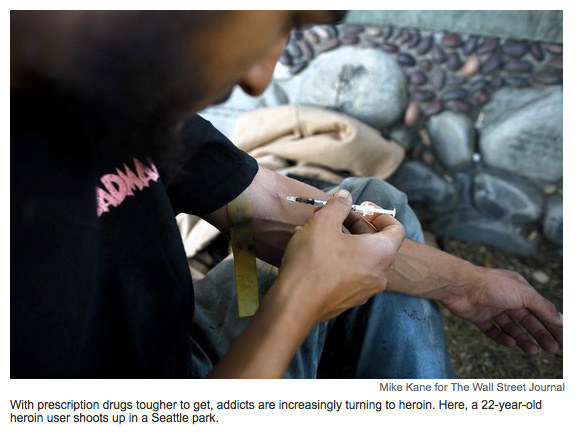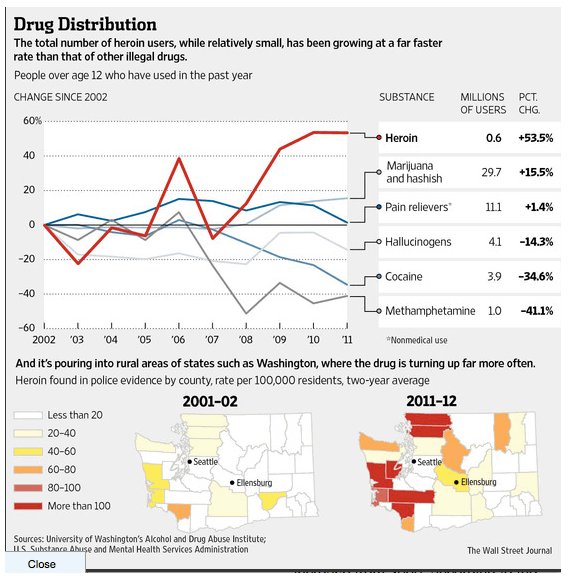| |
Heroin Makes a Comeback
|
| |
| |
"The number of people who say they have used heroin in the past year jumped 53.5% to 620,000 between 2002 to 2011, according to the Substance Abuse and Mental Health Services Administration. There were 3,094 overdose deaths in 2010, a 55% increase from 2000, according to the federal Centers for Disease Control and Prevention."
This Time, Small Towns are Increasingly Beset by Addiction, Drug-Related Crimes
Wall St Jnl Aug 8 2013
http://online.wsj.com/article_email/SB10001424127887323997004578640531575133750-lMyQjAxMTAzMDAwODEwNDgyWj.html
ELLENSBURG, Wash.-This small city east of the Cascade Mountains is known for its hay farms, rodeos and, increasingly, something more sinister: a growing heroin problem.

The drug surfaced in the past two years and is spawning a new generation of addicts. The fatal overdose of a state trooper's son in May convulsed the town-especially when the two men arrested and charged with selling him heroin turned out to be a county official's sons. They pleaded not guilty in Kittitas County Superior Court and are awaiting trial.
"It really shook our community," said Norman Redberg, executive director of Kittitas County Alcohol Drug Dependency Service. He has evaluated 27 heroin users in the fiscal year that ended June 30, compared with three in 2008. Ellensburg has 18,000 residents.

Heroin use in the U.S. is soaring, especially in rural areas, amid ample supply and a shift away from costlier prescription narcotics that are becoming tougher to acquire. The number of people who say they have used heroin in the past year jumped 53.5% to 620,000 between 2002 to 2011, according to the Substance Abuse and Mental Health Services Administration. There were 3,094 overdose deaths in 2010, a 55% increase from 2000, according to the federal Centers for Disease Control and Prevention.
Much of the heroin that reaches smaller towns such as Ellensburg comes from Mexico, where producers have ramped up production in recent years, drug officials say. Heroin seizures at the Southwest border, from Texas to California, ballooned to 1,989 kilograms in fiscal 2012 from 487 kilograms in 2008, according to figures from the Drug Enforcement Administration.
The heroin scourge has been driven largely by a law-enforcement crackdown on illicit use of prescription painkillers such as oxycodone and drug-company reformulations that make the pills harder to crush and snort, drug officials say. That has pushed those who were addicted to the pills to turn to heroin, which is cheaper and more plentiful.
"Basically, you have a generation of ready-made heroin addicts," said Matthew Barnes, special agent in charge of the DEA's Seattle division.
Given the growing supply, dealers have flooded local markets with heroin. Former users interviewed in Ellensburg, who didn't want to be identified, said dealers promoted the drug aggressively. A 21-year-old recovering addict said she made the switch from pain pills to heroin after her dealer one day held out both options in his hands and encouraged her to choose the cheaper one.
A former Marine who lives in Ellensburg said he switched to heroin after getting hooked on oxycodone prescribed to him for an injury suffered while serving overseas. "To me, it was identical," said the 28-year-old. "It's mind-numbing, an instant antidepressant." He was eventually arrested for writing bad checks; if he successfully completes drug treatment, charges will be dropped.
Drug experts say the heroin sold today is generally purer and thereby more potent than the varieties prevalent in past decades, increasing the risk of overdose. Moreover, the purity can vary enormously from one batch to the next. A baggie "may be 15% pure one day, and the next day it's 60%," said Skip Holbrook, the police chief in Huntington, W.Va., which sits in an area of Appalachia where heroin is spreading. "It's like playing Russian roulette."
In contrast to the 1970s and 1980s, when heroin ravaged inner-city neighborhoods, this time it is taking hold in rural places that are often unprepared to deal with the fallout, a trend noted in this year's White House National Drug Control Strategy report. Many lack addiction-treatment options. According to data analyzed by the Maine Rural Health Research Center, 93% of facilities nationwide with treatment programs for opioids, a class of pain-relief drugs including heroin, are located in metropolitan areas.
Small-town police forces strain to handle the additional narcotics investigations and drug-related crimes such as burglaries. Some afflicted areas are far from hospital emergency rooms, raising the risk that an overdose will be deadly. In Ellensburg, Kim Hitchcock, who works at a nonprofit public-health organization, has started a needle-exchange program in her spare time and taken young addicts released from the hospital following overdoses into her home. "There's a tremendous lack of services in our area," she said.
In Marinette, Wis., some employers are having difficulty filling positions because so many applicants are testing positive for heroin, said state Rep. John Nygren. The problem prompted the local chamber of commerce in April to begin assembling a consortium of community organizations to address the problem. Meanwhile, a sharp rise in heroin-related crime has fed a 31% increase in the inmate population at the 164-bed local jail over the past two years, said administrator Bob Majewski.
The town of 11,000 has no residential treatment centers for addicts. "If somebody says, 'I'm at bottom, I need help,' there's nothing that we have to give them," said Sgt. Scott Ries of the Marinette Police Department. "It's really sad."
The only option is to head to cities such as Green Bay, an hour away.
In some rural areas of Kentucky, communities "are experiencing heroin literally for the first time," said Bill Mark, director of the Northern Kentucky Drug Strike Force. Last year, 28 of the state's 120 counties logged their first heroin arrests since he started tracking such data in 2008, he said.
Back in Huntington, W.Va., heroin became the top drug problem in the city of around 50,000 about six months ago, said Mr. Holbrook, the police chief. Last month, a local task force nabbed 3.7 pounds of the drug, one of the largest seizures ever in the region. And police are contending with a steady increase in property crimes like larceny, driven by addicts trying to feed their habit.
The drug "transcends all areas of our town," Mr. Holbrook said. "It is absolutely the most pressing issue that we face."
|
|
| |
| |
|
|
|